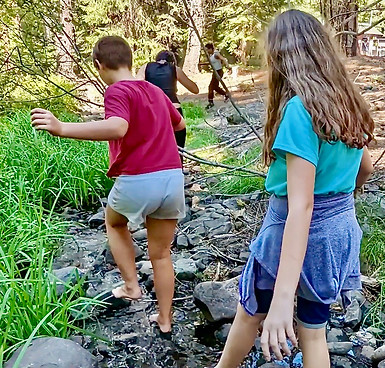
Montessori Education
“The greatest sign of success for a teacher..is to be able to say, 'The children are now working as if I did not exist. '” – Maria Montessori.

What is Montessori?
Montessori is a bottom up, student-centric method of education that has at its heart a creative approach to learning and all-encompassing worldview. As we are a middle school, each of the three grades interact with one another and share classes in an open air campus. The Montessori method encourages curiosity and all of the tools, implements, and manipulatives are available to each of the students in the school setting. The Montessori Method is eminently project-based and each project is informed by a variety of subjects and disciplines. And while the day is structured from beginning to end, it is the student’s responsibility to see that their time is spent efficiently and effectively in completing their assignments. Teachers in this case are more directors and guides than overtly instructive and are integral to a close, caring community of learners.
Benefits of Montessori
Using a student-centered learning model, each student is able to learn at their own pace, advancing through the curriculum as they are ready. Teachers are able to provide a more individualized learning plan to accommodate all levels. Through project-based learning, students become active seekers of knowledge, expand their ability for critical thinking, and develop collaboration skills. Freedom of structure inspires creativity and encourages students to express their individuality.


Curriculum Areas of Montessori
Social sciences, science, and geography: The student integrates history utilizing themes from earlier studies in natural and cultural history, including interdependency, evolution, life cycles, matter and energy, behavior and culture, mental health, physical health, agriculture, government, manufacturing, communication, world systems, earth preservation, and so on, in the context of social responsibility and governance. Primary readings from each historical period are emphasized.
Language arts: The student develops confidence in self-expression utilizing the seminar, oral presentation, debates, drama, video, photography, essays, play-writing, poetry, and short stories; explores related accounts of historical and philosophical material through literature utilizing components of style, genre, characterization, interpretation, and the art of discussion.
Second language and grammar: The student revisits grammar through the study of a second language and reviews complex sentences and paragraph structure in English.
Mathematics: The student uses higher-order thinking skills to solve problems in relation to a variety of challenges, from practical money transactions to algebraic relationships; explores in-depth numbers, properties, simple equations, higher measurement, computer calculation and graphics, geometric proofs, and algebraic equations.
Practical management: The student manages reality-based operations in economic enterprises including agriculture, fundraisers, travel, volunteerism and service, apprenticeship, and computer programming.
Fine arts: The student utilizes a discipline-based arts education plan which presents individual artistic areas of painting, acting, singing, composing, photography, dance, and sculpture, and includes a general education for aesthetic literacy which integrates the arts with other academic endeavors.
From NAMTA



